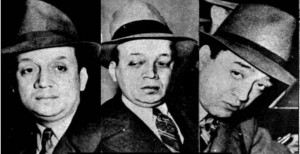
GOOD MORNING, P.O.U.!
This story needs to be made into a movie! It’s long, but VERY interesting….
THE JONES BROTHERS

(An excerpt from “The Legend of Tommy Roe”)
The Jones boys were the sons of a Baptist minister from the South who came to Chicago and died shortly afterwards, leaving a widow and three sons, Edward, George and McKissack. From a $16,000 life insurance policy, the boys’ mother set her sons up in the taxi cab business, one of the few that operated on the South side.
The taxi business boomed and the eldest Jones boy, Edward, a former Club Car Porter for Twentieth Century Limited, drifted into the policy game. He started at the bottom, as a slip runner and, after he had learned the business, persuaded his mother to lend him $15,000 to start his own wheel. She did, and by the late thirties, the Jones brother’s wheel was doing $10,000 to $15,000 a day. It grew because unlike other gamblers in the black neighborhoods, Jones paid off on time and in full. No excuses.
The Jones brothers funneled their cash into legitimate businesses and real estate, enough so that they became the biggest source of ready cash inside the Black belt.
They purchased the huge Ben Franklin department store on 47th Street, which employed 150 people. However, it was little more then a front for the Jones brothers’ policy bank. They also bought an enormous food store at 43rd and Prairie and several large apartment buildings all over the South Side and in the late 1930s they added the Vienna, the Grove, the Garfield and the Alpha to their holdings to go along with their villa in France, where their mother Harriet lived, a summer estate in Peoria and another villa in Mexico, just outside Mexico City, the brothers’ favorite vacation spot.
Then the entire family had chauffeured limos and lived in enormous mansions, Eddie designing and building his own twenty-one-room digs on South Michigan with custom-made French provincial furniture and gold bathroom fixtures. His wife Lydia was a former beauty queen in the Cotton Club Chorus line, who wore satin or mink every day.
They could afford it. Between 1933 and 1938, they had spent a remarkable $2,772,191.10 but paid taxes on about half that amount. But they didn’t spend it all, the money was tucked away in savings accounts, government secured bonds, industrial bonds, commercial real estate and about $1.6 million in various stocks.
The Jones were light skinned, powerful and popular figures inside the Black belt. They were better educated and better mannered then most policy gangsters and cared little, if at all, for the residents of the Black belt except to take their money. They were notorious cheapskates and trusted no one from the Black belt to hold a position inside their operations. As a result, all of their key people were white, and in the end that cost them everything.
Enter Billy Skidmore.
